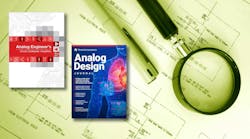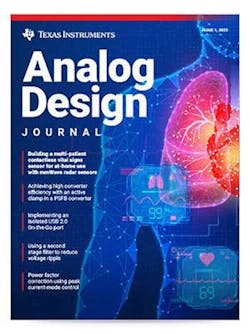Members can download this article in PDF format.
Thomas Jefferson once elegantly stated that some truths we can hold to be self-evident. In electronics design, one of these truths is this: Nature isn’t digital, and as such, analog signals will always be used to measure real-world data.
While digital chips calculate via the binary system of ones and zeroes, our real world doesn’t consist of ones and zeroes, but rather temperatures, pressures, velocities, etc. Analog deals with continuous signals. As an engineer, you will need to design analog circuits to process real-life voltages and currents.
Sponsored Resources:
- Speed Your System Design With the Data Converter Circuit Cookbook
- The Newest Analog Design Journal is Out Now
- Build Your Expertise With Our Power Design Resources
To do so, it takes engineers who have a firm grasp of fundamental electronic principles, including circuit analysis, circuit design, and semiconductor physics. Choosing analog components for a new design also requires the ability to judge characteristics such as signal frequency, signal amplitude, noise, linearity, power, and temperature.
This article focuses on how to accelerate your development as an engineer and expand your analog expertise using TI's comprehensive design resources.
Recipes Need a Cookbook
Texas Instruments’ comprehensive library of sub-circuit ideas, in the form of easy-to-use cookbooks, offers ways to help simplify and speed system design. The company’s Analog Engineer’s Circuit Cookbooks present 60+ amplifier and 40+ data-converter sub-circuit designs in two easy to use eBooks (Fig. 1).
Each circuit can be easily adapted to meet specific end equipment needs. Included are step-by-step instructions, basic formulas, schematic diagrams, and Spice simulations.
For example, you might use the cookbook to design a low-power amplifier to drive a successive-approximation-register analog-to-digital converter (SAR ADC) that consumes only microwatts of power during operation. Such a design might be intended for systems collecting sensor data and thus require a low-power signal chain that only burns single-digit microwatts of power.
Similarly, linear operation of an instrumentation amplifier depends on the linear operation of its primary building block: op amps. An op amp operates linearly when the input and output signals are within the device’s input common-mode and output-swing ranges, respectively. The supply voltages used to power the op amps define these ranges. Application Notes in the Analog Engineer’s Circuit Cookbook shows step by step how to design a two-op-amp or a three-op-amp instrumentation amplifier circuit.
From data converters to sensing, beginner to advanced engineer, the quarterly Analog Design Journal can provide answers to your analog design questions, written by the industry's most knowledgeable engineers (Fig. 2).
It can help you understand, for instance, that current consumption in an ADC datasheet is an average value specified at steady-state operating conditions. By grasping the information about ADC power-supply parameters presented in the datasheet, you can design more reliable precision data-acquisition (DAQ) systems.
Build Your Expertise with TI’s Power Design Resources
Since its introduction in 1977, the Power Supply Design Seminar (PSDS) series has reported on technical topics that combine new advanced power-supply concepts, basic design principles, and real-world application examples. It never hurts for even veteran engineers to brush up on these basics of the profession, simply as a review for those experienced in power-supply design. Thus, the topics presented will be worthwhile for all levels of expertise.
The Power Supply Design Seminar 2024 is now open for registration. In-person sessions will be held during March in the U.S., China, Taiwan, Korea, Singapore, Japan, Germany, and Czech Republic, with sessions in India coming in June.
Simplifying Design with Complete Packages
Every analog and embedded device from TI features associated design resources, ranging from product selection and simulation tools to evaluation hardware and software development kits. These resources are specifically designed to help you evaluate, prototype, develop, and get to production as quickly as possible. Together with TI’s extensive partner network, library of training content, and direct technical support, you can leverage the analog and embedded expertise throughout your entire design cycle.
From voltage regulators to precision data converters, TI’s portfolio solves design challenges for any application. In addition, comprehensive suites of analog and embedded processing design tools, resources, and training help guide you from product selection to simulation and layout.
What’s more, TI’s continued investments in internal manufacturing, packaging innovation, and purchasing tools can assist in getting you the analog parts necessary for the job at hand.
Sponsored Resources:


